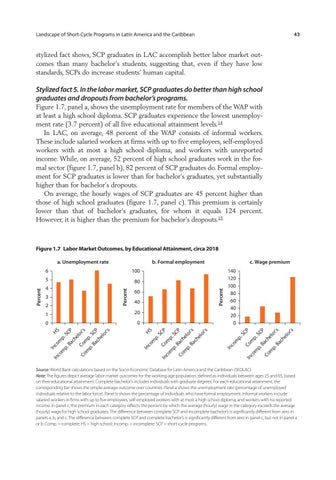43
Landscape of Short-Cycle Programs in Latin America and the Caribbean
stylized fact shows, SCP graduates in LAC accomplish better labor market outcomes than many bachelor’s students, suggesting that, even if they have low standards, SCPs do increase students’ human capital.
Stylized fact 5. In the labor market, SCP graduates do better than high school graduates and dropouts from bachelor’s programs. Figure 1.7, panel a, shows the unemployment rate for members of the WAP with at least a high school diploma. SCP graduates experience the lowest unemployment rate (3.7 percent) of all five educational attainment levels.14 In LAC, on average, 48 percent of the WAP consists of informal workers. These include salaried workers at firms with up to five employees, self-employed workers with at most a high school diploma, and workers with unreported income. While, on average, 52 percent of high school graduates work in the formal sector (figure 1.7, panel b), 82 percent of SCP graduates do. Formal employment for SCP graduates is lower than for bachelor’s graduates, yet substantially higher than for bachelor’s dropouts. On average, the hourly wages of SCP graduates are 45 percent higher than those of high school graduates (figure 1.7, panel c). This premium is certainly lower than that of bachelor’s graduates, for whom it equals 124 percent. However, it is higher than the premium for bachelor’s dropouts.15
Figure 1.7 Labor Market Outcomes, by Educational Attainment, circa 2018
p.
Ba
ch
el
or ’s
or ’s
P
m Co
m
p.
Ba
ch
el
SC
P
p. m co In
m
p.
Co
p.
Ba
ch
el
SC
or ’s
or ’s
P
el
Co
m
p.
Ba
ch
SC
P SC
m p. m
p. m
Co
co
el
SC
Ba
ch
p. m co In
co In
In
0
m p.
0
P
20
o Co Com r’s m p. p. S Ba CP ch el or ’s
1
HS
40
co
2
60
In
Percent
3
co
80
4
140 120 100 80 60 40 20 0
In
100
5
c. Wage premium
Percent
b. Formal employment
6
HS
Percent
a. Unemployment rate
Source: World Bank calculations based on the Socio-Economic Database for Latin America and the Caribbean (SEDLAC). Note: The figures depict average labor market outcomes for the working-age population, defined as individuals between ages 25 and 65, based on their educational attainment. Complete bachelor’s includes individuals with graduate degrees. For each educational attainment, the corresponding bar shows the simple average outcome over countries. Panel a shows the unemployment rate (percentage of unemployed individuals relative to the labor force). Panel b shows the percentage of individuals who have formal employment. Informal workers include salaried workers in firms with up to five employees, self-employed workers with at most a high school diploma, and workers with no reported income. In panel c, the premium in each category reflects the percent by which the average (hourly) wage in the category exceeds the average (hourly) wage for high school graduates. The difference between complete SCP and incomplete bachelor’s is significantly different from zero in panels a, b, and c. The difference between complete SCP and complete bachelor’s is significantly different from zero in panel c, but not in panel a or b. Comp. = complete; HS = high school; Incomp. = incomplete; SCP = short-cycle programs.

